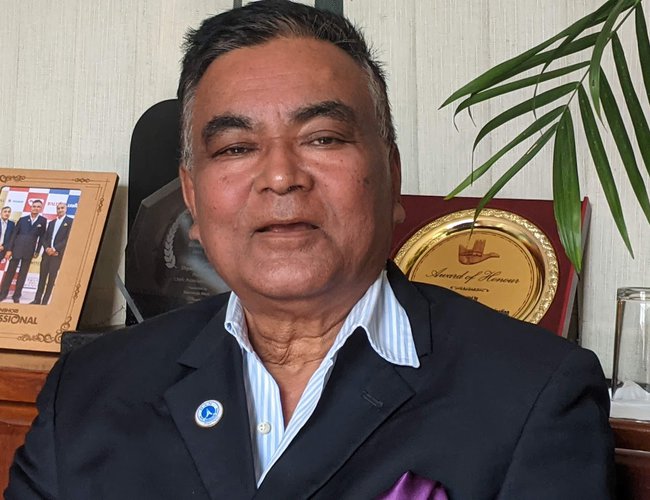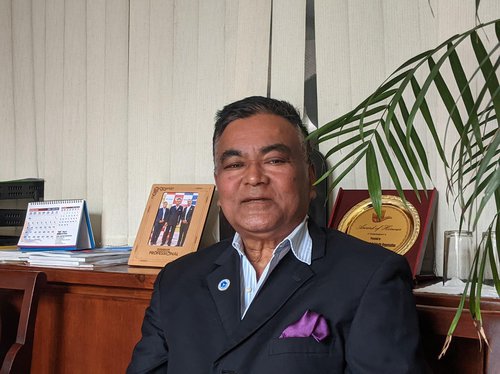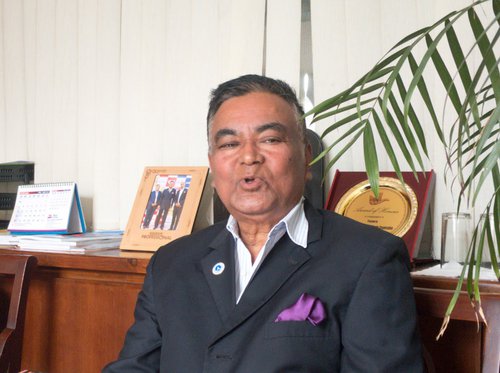
How do you observe tourism sector in Nepal?
Before delving into our discussion, I would like to extend heartfelt condolences and pay tribute, on behalf of Hotel Association Nepal, to the late Ambica Shrestha and Shyam Bahadur Pandey. These two iconic figures in the tourism sector played a significant role in promoting Nepal as a global tourism destination. The passing of Shrestha, the founder of Dwarika Hotel, and Pandey, the founder of Hotel Shangri-La, marks a significant loss for Nepalese tourism during this critical period.
How do you see the state of tourism in Nepal ?
The state of tourism in Nepal is currently facing challenges despite some progress in tourist arrivals post-COVID-19. The number of available rooms now exceeds the number of tourists arriving, indicating a critical situation in the tourism sector. Before we proceed, I would like to extend our heartfelt condolences and pay tribute to the late Ambica Shrestha and Shyam Bahadur Pandey, two esteemed tourism entrepreneurs who made significant contributions to promoting Nepal as a tourism destination. Their passing is a great loss, especially during this critical time. The recent visit of HAN's delegation to Dhaka and China aimed to promote Nepal's tourism, and we were able to engage extensively with tourism entrepreneurs in both countries, thanks to the support of Nepal's diplomatic missions.
How would you describe your visit?
We had a delegation of 75 members in China and a delegation of 21 members in Bangladesh. Following the COVID-19 pandemic, both Chinese and Bangladeshi individuals have shown a keen interest in Nepal. Travel agencies and tourism entrepreneurs in both countries have expressed interest as well. We have received a positive response from both nations. Our delegation conveyed a strong message that Nepal can offer the necessary products for tourists from China and Bangladesh.
What about your visit to China?
Regarding the visit to China, prior to COVID-19, there were six daily flights between Nepal and China. However, this number has decreased, highlighting the need for Nepal to enhance air connectivity. Additionally, exploring the Rasuwagadhi road is essential. Our observation indicates that Chinese individuals are interested in visiting Nepal, presenting an opportunity to attract numerous Chinese tourists. During Prime Minister Pushpa Kamal Dahal Prachanda's visit in September last year, China agreed to launch Visit Nepal Year 2025 in China, aiming to increase the influx of Chinese tourists to Nepal. While this initiative is still in its early stages, Nepal can develop comprehensive plans to actualize this goal. This involves enhancing connectivity, facilities, services for Chinese tourists, and more. Furthermore, Nepal should engage in additional promotional activities to showcase Nepal as a premier tourist destination.
The impression of visiting Bangladesh is quite positive, as evidenced by the fact that Bangladeshis are now the fourth largest group of visitors to Nepal. Last year, over 38,000 tourists from Bangladesh traveled to Nepal, and there is potential to double this number. To achieve this, it is essential to enhance connectivity and promotional efforts in Bangladesh. Tourism entrepreneurs in Bangladesh have suggested using taka instead of hard foreign currency for exchange, which could benefit both countries. Nepal currently imports a significant amount of materials from Bangladesh, paying in dollars, but a change in exchange rate could create a win-win situation. Discussions on this matter have already taken place with government officials.
How about your visit to Bangladesh?
The impression of visiting Bangladesh is quite positive, as evidenced by the fact that Bangladeshis are now the fourth largest group of visitors to Nepal. Last year, over 38,000 tourists from Bangladesh traveled to Nepal, and there is potential to double this number. To achieve this, it is essential to enhance connectivity and promotional efforts in Bangladesh. Tourism entrepreneurs in Bangladesh have suggested using taka instead of hard foreign currency for exchange, which could benefit both countries. Nepal currently imports a significant amount of materials from Bangladesh, paying in dollars, but a change in exchange rate could create a win-win situation. Discussions on this matter have already taken place with government officials.

What are your predictions for the future of tourism activities post-COVID-19 pandemic?
There seems to be a positive trend in the tourism sector, with an increase in the number of tourists arriving in Nepal by air. However, the occupancy rate in hotels is decreasing, and many are operating at a loss.
What do you foresee for the tourism industry in the coming years?
Following the COVID-19 pandemic, the tourism sector has experienced significant growth, with numerous positive indicators emerging. In 2023, approximately 1 million tourists arrived in Nepal via air travel. Over the last seven months of 2024, the average monthly arrival of tourists by air has been 100,000. The number of tourists arriving by road is yet to be determined, although an equivalent number of Indian tourists visit Nepal by road. Furthermore, the influx of world-class hotel brands into the country is on the rise, with new hotels being constructed to increase capacity. However, the occupancy rate is declining. The government has issued licenses for 22 five-star hotels, of which 20 are currently operational. Interestingly, by the end of 2025, more than 22 five-star hotels will be added to the country. Most of these hotels have already been built and are now operational. With the current capacity to accommodate over 3.5 million people, the current arrival rate of approximately 1.2 million will be insufficient. We are only utilizing one-third of our capacity, which is not enough to break even. A minimum of 40 percent occupancy is required to break even. Despite a few new hotels, the majority of hotels are currently operating at a loss.
What is your opinion on the policy?
The political leadership has shown support, but the bureaucracy has been unsupportive towards the hotel sector. Despite the government making changes to the policy and law during the Nepal Investment Forum last year, the hotel industry was not recognized as a service industry. This decision was politically approved but later removed by the bureaucrats, which is unfortunate. Hotels require significant investment, yet they are not categorized as service enterprises, unlike vegetable shops and motorcycle workshops, which is unjustifiable.
Nepal now has three international airports with the capacity of over 150 million tourists but Nepal depends on TIA. Why doesn't the tourism sector press the government to make Pokhara and Gautam Buddha International Airport operational?
Yes, Nepal currently has three international airports, capable of accommodating over 150 million tourists, yet the country heavily relies on Tribhuvan International Airport (TIA). Despite efforts to push the government for the operationalization of Pokhara and Gautam Buddha International Airport, the government has cited the necessity of an additional entry route from India to make both airports functional. Furthermore, the government has assured ongoing negotiations with India to address technical issues hindering the operation of Gautam Buddha International Airport. The successful operation of both international airports has the potential to significantly transform the country, as evidenced by TIA's projected doubling of passenger capacity to 100 million upon the completion of the current expansion phase. This development is indeed promising.

What Nepal needs to Do?
Nepal has to seek solutions to the operational challenges at Gautam Buddha International Airport, rather than attributing the issues to technical and bilateral factors. Kuwait Airlines has already initiated flights at the airport, and it is imperative for Nepal Airlines and Himalayan Airlines to follow suit. Furthermore, the government should consider incentivizing airlines from Vietnam, Cambodia, Laos, China, and Thailand to commence charter flights by offering them concessional rates. The Civil Aviation Authority of Nepal must play a proactive role in this endeavor. In addition, the private sector should be motivated to take on ground handling responsibilities, and if necessary, the government should explore the option of engaging foreign companies, as this has become a common practice in the industry. Efforts in this direction must be intensified.
How your observation in Bangladesh?
We received a positive response from both countries. Ambassador Ghanshyam Bahandari showed a strong interest in Bangladesh. There is a significant opportunity to attract a large number of tourists from Bangladesh. Our delegation traveled to Dhaka to explore opportunities and engage with tourism entrepreneurs in Bangladesh. Through our interactions, we anticipate that the number of tourists from Bangladesh will double in the next few months due to improved connectivity.
How do recent air crashed of Saurya Airlines affect Nepal’s tourism revival?
As for the Surya Airlines accident, it was a tragic and unfortunate event during a critical time. This incident has raised concerns about air safety at a time when Nepal's tourism sector was making progress. It is likely to have a negative impact on the tourism sector in the coming years. Nepal must address air safety issues and take decisive actions to prevent future accidents. Additionally, Nepal's presence on the European Union's blacklist for over eight years will likely be prolonged due to this crash, further delaying the possibility of being removed from the list.
At a time when many sectors are jubilant over the recently announced monetary policy, what is your view as the President of Hotel Association of Nepal (HAN)?
As the President of Hotel Association of Nepal, I believe that the recently announced monetary policy has failed to address the concerns of hoteliers. In simple terms, the policy has overlooked the issues faced by hoteliers.
Have you not discussed the issues with the concerned authorities including the Governor and Finance Minister?
The HAN delegation visited all of them and informed them about our issues. We have requested actions such as refinancing and rescheduling of loans, as well as boosting the tourism sector through low interest rates. Unfortunately, the monetary policy has not tackled these concerns. Even the current fiscal year's budget and monetary policy have acknowledged the underutilization of hotel capacity, with occupancy rates below one third. Despite an increase in tourist arrivals and economic activities picking up, the hotels' capacity, which continues to expand, is only around 30 percent utilized. This level is insufficient to cover basic operational expenses. Consequently, the hotel industry is facing losses and struggling to meet regular interest payments to the banks, as highlighted in the statement.
How do you compare the current monetary policy with last year?
The current monetary policy differs from last year's in several ways. Last year, there were provisions for refinancing and rescheduling interest payments to banks, which are not present in the new policy. This has caused confusion among hotel and tourism operators.

Keshab Poudel
Poudel is the editor of New Spotlight Magazine.
- ERC Nepal Is Focused On Expanding Distribution And Transmission To The Private Sector: ERC Chair Dr. Dhital
- Jul 06, 2025
- FOURTH PROFESSOR Y.N. KHANAL LECTURE: Nepal-China Relations
- Jun 23, 2025
- Colonel JP CROSS: Centenary Birthday
- Jun 23, 2025
- BEEN: Retrofitted For Green
- May 28, 2025
- GGGI has been promoting green growth in Nepal for a decade: Dr. Malle Fofana
- May 21, 2025















